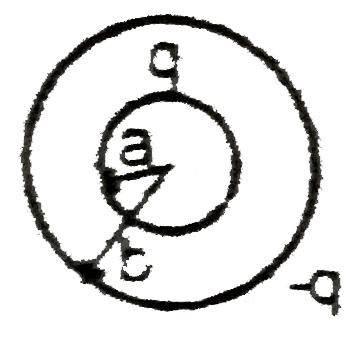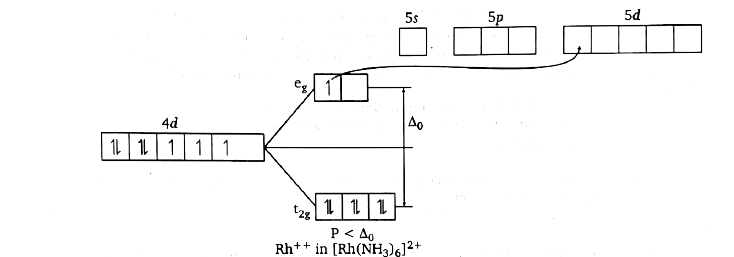Crystal field theory provides correct electronic distribution of central metal under surrounding ligannd field, hence it clearly explains magnetic moment, colour of a complex.
Q. In which of the following complex transition of electron occurs from one shell to other shell of central metal.
[Fe(H2O)5(NO)]2+
[Co(H2O)6]2+
[Rh(NH3)6]2+
[Ni(CN)6]4−
The correct Answer is:C
Topper's Solved these Questions
- BOOK - VK JAISWAL ENGLISHCHAPTER - CO-ORDINATION COMPOUNDSEXERCISE - ONE OR MORE ANSWERS IS/ARE CORRECT71videos
CO-ORDINATION COMPOUNDS
- BOOK - VK JAISWAL ENGLISHCHAPTER - CO-ORDINATION COMPOUNDSEXERCISE - MATCH THE COLUMN36videos
CO-ORDINATION COMPOUNDS
- BOOK - VK JAISWAL ENGLISHCHAPTER - CO-ORDINATION COMPOUNDSEXERCISE - LEVEL 2144videos
CO-ORDINATION COMPOUNDS
- BOOK - VK JAISWAL ENGLISHCHAPTER - CHEMICAL BONDING (BASIC)EXERCISE - SUBJECTIVE PROBLEMS54videos
CHEMICAL BONDING (BASIC)
- BOOK - VK JAISWAL ENGLISHCHAPTER - d-BLOCK ELEMENTSEXERCISE - ASSERTION-REASON TYPE QUESTIONS32videos
d-BLOCK ELEMENTS
Similar Questions
Crystal field theory provides correct electronic distribution of central metal under surrounding ligannd field, hence it clearly explains magnetic moment, colour of a complex.
Q. Which of the following complex is high spin?View SolutionCrystal field theory provides correct electronic distribution of central metal under surrounding ligannd field, hence it clearly explains magnetic moment, colour of a complex.
Q. Which of the following hydrated complex ion has high intensity colour in aqueous solution.View SolutionThe crystal field theory assumes interaction between metal ion and the ligands as a purely electrostatic and ligands are supposed to be point charges.
Q. Amongst the following complexes which has square planar geometry?View SolutionThe crystal field theory assumes interaction between metal ion and the ligands as a purely electrostatic and ligands are supposed to be point charges.
Q. Amongst the following complexes which has square planar geometry?View Solutiona) Give the electronic configuration of the d-orbitals of Ti in [Ti(H2O)6]3+ ion in the octahedral crystal field.
b) Why is this complex coloured ? Explain on the basis of distribution of electrons in d-orbitals.View SolutionWhich of the following statements is correct with regard to complex ion ? .
(a) complex ion consists of a central ion bonded to two or more donor ions or molecules usually does not dissociate into simple ions or molecules even in a solution and exhibits properties different from its constituent ions or molecules
(b) The donor ions and molecues which coordinate with the central atom or ion a complex are called ligands
The sum of the number of electrons pressent in the central metal ion or atom and those donated by the ligands is called the effective atomic number of the central metal aton and this number is usually the same as the atomic number of the next higher noble gas
(d) All of these .View SolutionFigure shows two concentric shells of radii a and b uniformly distributed charges q and -q. Which of the following graphs gives correct variation of electric field intensity E with the distance r from the centre?
 View Solution
View SolutionCrystal field theory with its assumptions of completely electrostatic metal-ligand interactions, does not appear to retionalize the spectrochemical series particularly well. To explain the order of ligands in the series we must admit some covalent contribution to the metal ligand bond, both sigma and pi.
Sigma bonds are formed by ligands using their p orbitals (e.g. Cl−) or by hybrid orbitals (e.g. sp3) by (H2O) since all ligands are capable of such sigma interaction, this is not very useful in rationalizing spectrochemical series. The pi bonding ability of ligands partially justifies their position in spectrochemical series. pi-acid ligands. which can accept electron density from filled metal orbital into their empty orbital via pi interation appear towards stronger/higher and of the series e.g. CN−.PR3 etc. While sigma-donor ligands are typically weak field ligands e.g. Cl−,O2− etc.
Q. Which of the following d orbitals of the central atom is useful for sigma bond formation with ligands in octahedral field?View SolutionCorrect the following statements by changing the under lined part of the sentence (Do not change the whole sentence)
In a coordination complex, donation of electron pair takes place from the central metal atom to the ligands.View SolutionThe IUPAC definition of a transition element is that it is an element that has an incomplete d-subshell in either the neutral atom or its ion. Thus the group 12 elements are member of the d-block but are not transition elements.
Chemically solft members of the d-block occurs as sulphide minerals and are partially oxidised to obtain the metal, the more electropositive 'hard' metals occurs as oxides and are extracted by reduction.
Opposite to p-block elements, the higher oxidation states are favoured by the heavier elements of d-block Metals on the right of the d-block tend to exist in low oxidation states and form complexes with the ligands. Square-planar complexes are common for the platinum metals and gold in oxidation states that yield d8 electronic configuration, which include RH(I),Ir(I),Pd(II),Pt(II) and Au(III).
The most distinctive features/properties of transition metal complex is their wide range of colours.The crystal field theory attributes the colour of the coordination compounds to d-d transition of the electron.It is important to note that (a) in absence of ligand, crystal field spilling does not occur and hence the substances is colourless, (b) the type of ligand also influences the colour of the complexes.
Which of the following has dsp2 hybridisation and is diamagnetic in nature ?
(i)Na4[Cr(CO)4] , (ii)[Ni(DMGH)2] , (iii)[PtHBr(PEt3)2]
(iv)[As(SCN)4]3− , (v)[AuBr4]−View Solution


